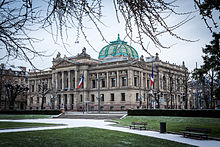Bibliothèque nationale et universitaire de Strasbourg
The Bibliothèque nationale et universitaire de Strasbourg (BNUS; German National and University Library of Strasbourg ) in Strasbourg , with over three million media units, is the second largest collection in France after the Bibliothèque nationale de France in Paris . It is the depository library for the Alsace region and the university library of the University of Strasbourg .
The special collections, which have been rebuilt since 1872, comprise around 6,900 manuscripts, including around 700 from the Middle Ages, including codices with writings by Heinrich Seuse , Meister Eckhart and Johann Tauler . The 2098 incunabula include copies from the Strasbourg printers such as Heinrich Eggestein , Johannes Mentelin and Hans Grüninger .
history
The German Era (1870-1918)
In August 1870, the Strasbourg city library in Temple Neuf was completely destroyed in the Franco-Prussian War . The Donaueschingen court librarian Karl August Barack called for book donations for the reconstruction of the library and was an enormous success. By the time the library opened, 120,000 gifts had been collected. The library was opened on August 9, 1871 in the Palais Rohan as a university library, and Barack was appointed library director. In June 1872 the library was named University and State Library . The facility received massive support from the German Empire and had a high acquisition budget. The stocks exceeded the million mark in 1913.
The building was erected from 1889 to 1894 according to designs by the architects August Hartel and Skjøld Neckelmann in the center of the new town on Kaiserplatz (today Place de la République ) in the style of historicism based on the models of the Italian Renaissance . The construction costs amounted to 1.4 million Reichsmarks, the costs for the interior furnishings amounted to 285,000 Reichsmarks. So-called " Lipman shelves " were installed here as the first library building . The new library building was officially inaugurated on November 29, 1895.
After Barack's death in 1900, Julius Euting took over the management of the library, which under his direction became one of the leading oriental studies libraries in the world. In 1901 a collection of 2,000 papyri and 2,000 ostraka was acquired. In 1905, the estate of the racial theorist Count Joseph Arthur von Gobineau acquired the largest special collection in the history of the library. In 1909 Euting retired at the age of 70.
Euting's successor was Georg Wolfram (1858–1940), who had previously been the Imperial Archive Director in Metz. Under his leadership, the library's staff, funds, and inventory grew.
During the First World War, the library was initially closed, and valuable holdings were stored in a fire-proof manner, as the siege of Strasbourg was expected. The library stood out in particular through the establishment of hospital libraries, some of which were also built with duplicates from the library. After the end of the war, the "Alsatian National Council" transferred the management of the library on November 20, 1918 to the senior librarian Karl Klein. The 21 old German officials of the library were expelled to Germany.
The French period from 1918 to 1940
In February 1919, the management was transferred to the young French librarian Ernest Wickersheimer (1880–1965), who now bore the title "Bibliothèque universitaire et régionale" and was placed on an equal footing with the French university libraries. Following the French model, the inventory of the holdings has now been changed from a systematic to a numerus currens (within systematic large groups). The catalogs became publicly available and various departments were set up in the library organization. As the second largest library in France and based on the "ancien statut allemand", the library was given the name "Bibliothèque Nationale et Universitaire", which is still valid today, in 1926. A particular focus of the collection was literature from and about Germany.
The library in World War II
At the beginning of the Second World War, all approx. 1.5 million volumes and the catalogs were transferred to Clermont-Ferrand from the beginning of September 1939 . After the invasion of the German troops, the head of the Colmar City Library, Franz Albert Schmitt (1895–1967; also: Schmidt-Leinen and Schmitt-Claden and as a pseudonym: P. (aul) M. (aria) Morand Claden) was appointed on 10. In July 1940 he was appointed acting head of the Strasbourg University and State Library, which is now again known as this. On instructions from the Germans, the library holdings were transported back to Strasbourg from mid-March to October 1941; the library came under the responsibility of the Reich Ministry of Education. In May 1941 Karl-Julius Hartmann was appointed provisional director of the library, who also remained director of the Göttingen University Library.
The interior, which was destroyed in the Second World War, was rebuilt from 1951 to 1956 from a functional perspective.
literature
- Henri Dubled: Histoire de la Bibliothèque Nationale et Universitaire de Strasbourg. 2nd edition, Strasbourg 1973.
- Peter Borchardt: The German library policy in Alsace. On the history of the University and State Library of Strasbourg 1871–1944 . In: Paul Kaegbein and Peter Vodosek (eds.): State initiative and library development since the Enlightenment. Wiesbaden: Harrassowitz 1985 (Wolfenbütteler Schriften zur Geschichte des Buchwesens 12), pp. 155–213.
- Volker Wittenauer: The library policy of the Bibliothèque Nationale et Universitaire de Strasbourg, presented in the project of the retro-conversion of the card catalog of the German period (1870-1918). Heidelberg 2005. ( online ; contains an outline of the history of the library)
Web links
- Official website
- Entry in Calames (Catalog en Ligne des Archives et des Manuscrits de l'Enseignement Supérieur) on the manuscripts of the library
Individual evidence
Coordinates: 48 ° 35 ′ 14 " N , 7 ° 45 ′ 21" E

